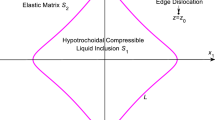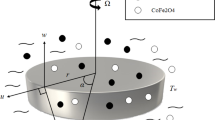Abstract
A mathematical model in integral format is devised for the development of instant temperature at the interface between a low melting temperature solid cylindrical additive and the freezing layer of the bath material around the additive immediately after immersion of the additive in the bath. It indicates that this temperature is function of the phase change parameters, the Stefan number, S ta of the additive, and S tb of the bath material, the thermophysical property-ratio, γ and the melting temperature ratio, θ ab of the additive-bath system and gives a close form expression for the instant interface temperature, θ e. For given θ ab < 1 and the Stefan number, S ta, of the additive decreasing the Stefan number, S tb of the bath material (∞ ≥ S tb ≥ 0) or increasing γ (0 ≤ γ ≤ ∞) permits θ e to increase from the initial temperature of the additive to the freezing temperature of the bath material. θ e also gets increased by increasing any or both of S tb and θ ab. When the additive gets only heated after its immersion in the bath, the model of the present problem becomes exactly the same that was investigated recently validating the present problem.










Similar content being viewed by others
Abbreviations
- B i :
-
Biot number, hr 0/K a
- B im :
-
Modified Biot number, (hr 0/K a) × (K a C a/K b C b)
- C :
-
Heat capacity (ρC p) (J m−3 K−1)
- C p :
-
Specific heat (J kg−1 K−1)
- C r :
-
Heat capacity ratio, C b/C a
- h :
-
Heat transfer coefficient (Wm−2 K−1)
- K :
-
Thermal conductivity (Wm−1 K−1)
- L :
-
Latent heat of fusion (J kg−1)
- r :
-
Radius (m)
- R ah :
-
Non-dimensional radius in the heat penetration region of the additive, (r ah/r a)
- R ai :
-
Non-dimensional radius of the heat penetration front in the additive at any time, (r ai/r a)
- R bf :
-
Non-dimensional radius within the frozen layer region, (C b r bf/C a r a)
- R bm :
-
Non-dimensional radius of the frozen layer front at anytime, (C b r bm/C a r a)
- S ta :
-
Stefen number of the additive, C a(T am − T ai)/L a ρ a
- S tb :
-
Stefen number of the bath material, C b(T bm − T ai)/L b ρ b
- t :
-
Time (s)
- T :
-
Temperature (K)
- T b :
-
Bulk temperature of the bath material (K)
- T e :
-
Instant equilibrium temperature at the interface between the additive and the frozen layer (K)
- α :
-
Thermal diffusivity (m2 s−1)
- γ :
-
Property-ratio, (K b C b/K a C a)
- ρ :
-
Density (kg m−3)
- θ :
-
Non-dimensional temperature, (T − T ai/T bm − T ai)
- τ :
-
Non-dimensional time, (K b C b/C 2a r 20 )t
- a:
-
Cylindrical additive
- ai:
-
Initial condition of additive
- af:
-
Within melting or freezing region of additive
- ah:
-
Within heating region of additive
- am:
-
Melting or freezing of additive
- b:
-
Frozen bath material or bulk condition of bath material
- bf:
-
Within melting or freezing region of bath material
- bm:
-
Melting or freezing condition of bath material
References
R. P. Singh, and A. Prasad: Ironmaking and Steelmaking, 2005, vol. 32, pp. 411–17.
Singh UC, Prasad A, Kumar A (2011) Metall. Mater. Trans. B 42B, pp. 800–06.
A. Prasad, and J. Nandi: Energy, 1992, vol. 17, pp. 413–17.
E.R.G. Eckert and R.M. Drake: Analysis of Heat and Mass Transfer, International Student Edition, McGraw-Hill Koga Kusha, Tokyo, Japan, 1972.
H.S. Carslaw and J.C. Jaeger: Conduction of Heat in Solids, Clarendon Press, Oxford, 1959.
M. Epstein: Nucl. Sci. Eng., 1973, vol. 51, pp. 84–87.
M. Epstein, and G.M. Hauser: Nucl. Eng. Des., 1979, vol. 52, pp. 411–28.
A. Prasad, and S.P. Singh: Trans. ASME, 1994, Vol. 116, pp. 218–23.
A. Prasad: J. Spacecraft Rockets, 1980, vol. 17, pp. 474–77.
A. Prasad and S. Prasad: Proceeding of International Symposium on Cold Region Heat Transfer, Sapporo, Japan, 1989, pp. 175–81.
U. C. Singh, A. Prasad, and A. Kumar: J. Min. Metall. Sec. B, 2012, vol. 48B, pp. 11-23.
B.T.F. Chung, and L.T. Yeh: J. Spacecraft Rockets, 1975, vol. 12, pp. 329–30.
R. P. Singh, and A. Prasad: Math. Comput. Model., 2003, vol. 37, pp. 849–62.
A.S. Wood: Appl. Math. Modell. 2001, Vol. 25, pp. 815–24.
S.L. Michell, and T.G. Myes: SIAM Rev., 2010, Vol. 52, pp. 57–86.
Author information
Authors and Affiliations
Corresponding author
Additional information
Manuscript submitted November 23, 2014.
Rights and permissions
About this article
Cite this article
Prasad, S., Prasad, A. & Kumar, A. Development of Instant Interface Temperature at Time τ = 0+ of Low Melting Temperature Cylindrical Solid Additive-Bath System. Metall Mater Trans B 46, 2616–2627 (2015). https://doi.org/10.1007/s11663-015-0417-8
Published:
Issue Date:
DOI: https://doi.org/10.1007/s11663-015-0417-8




